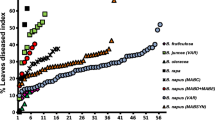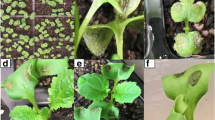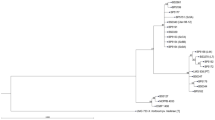Abstract
Light leaf spot (Pyrenopeziza brassicae) is an important disease on winter oilseed rape crops (Brassica napus) in northern Europe. In regions where economically damaging epidemics occur, resistance to P. brassicae in commercial cultivars is generally insufficient to control the disease without the use of fungicides. Two major genes for resistance have been identified in seedling experiments, which may operate by decreasing colonisation of B. napus leaf tissues and P. brassicae sporulation. Much of the resistance present in current commercial cultivars is thought to be minor gene-mediated and, in crops, disease escape and tolerance also operate. The subtle strategy of the pathogen means that early colonisation of host tissues is asymptomatic, so a range of techniques and molecular tools is required to investigate mechanisms of resistance. Whilst resistance of new cultivars needs to be assessed in field experiments where they are exposed to populations of P. brassicae under natural conditions, such experiments provide little insight into components of resistance. Genetic components are best assessed in controlled environment experiments with single spore (genetically fixed) P. brassicae isolates. Data for cultivars used in the UK Recommended List trials over several seasons demonstrate how the efficacy of cultivar resistance can be reduced when they are deployed on a widespread scale. There is a need to improve understanding of the components of resistance to P. brassicae to guide the development of breeding and deployment strategies for sustainable management of resistance to P. brassicae in Europe.




Similar content being viewed by others
Abbreviations
- ELISA:
-
Enzyme-linked immunosorbent assay
- HR:
-
Hypersensitive response
- qPCR:
-
Quantitative polymerase chain reaction
- QTL:
-
Quantitative trait loci
- R gene:
-
Major resistance gene
- SEM:
-
Scanning electron micrograph
References
Agrios, G. N. (2005). Plant pathology (5th ed.). London: Academic Press Ltd.
Ashby, A. M. (1997). A molecular view through the looking glass: The Pyrenopeziza brassicae – Brassica interaction. Advances in Botanical Research, 24, 31–70.
Ashby, A. M. (1998). Identification and partial characterization of a developmentally regulated protein involved in sexual morphogenesis in the discomycete plant pathogen Pyrenopeziza brassicae. Physiological and Molecular Plant Pathology, 53, 1–15.
Ashby, A. M. (2000). Biotrophy and the cytokinin conundrum. Physiological and Molecular Plant Pathology, 57, 147–158.
Aubertot, J. N., West, J. S., Bousset-Vaslin L, Salam, M. U., Barbetti, M. J., & Diggle, A. J. (2006). Improved resistance management for durable disease control: A case study of phoma stem canker of oilseed rape (Brassica napus). European Journal of Plant Pathology, 114, 91–106.
Baierl, A., Evans, N., Steed, J. M., Sutherland, K. G., & Fitt, B. D. L. (2002). Effects of light leaf spot (Pyrenopeziza brassicae) infection on winter survival and yield of oilseed rape (Brassica napus). Proceedings of the BCPC Conference 2002 – Pests & Diseases, 2, 629–634.
Baker, E. A. (1974) The influence of environment on leaf wax development in Brassica oleracea var. gemmifera. New Phytologist, 73, 955–966.
Balesdent, M. H., Desthieux, I., Gall, C., Robin, P., & Rouxel, T. (1995). Quantification of Leptosphaeria maculans growth in cotyledons of Brassica napus using ELISA. Journal of Phytopathology, 143, 65–73.
Ball, A. M., Siddiq, A. A., & Giltrap, N. J. (1990). Assessment of benomyl resistance and mating type in field isolates of Pyrenopeziza brassicae, cause of light leaf spot of Brassicas. Plant Pathology, 39, 33–37.
Ball, A. M., Ashby, A. M., Daniels, M. J., Ingram, D. S., & Johnstone, K. (1991). Evidence for the requirement of extracellular protease in the pathogenic interaction of Pyrenopeziza brassicae with oilseed rape. Physiological and Molecular Plant Pathology, 38, 147–161.
Ballinger, D. J., & Salisbury, P. A. (1996). Seedling and adult plant evaluation of race variability in Leptosphaeria maculans on Brassica species in Australia. Australian Journal of Experimental Agriculture, 36, 485–488.
Batish, S., Hunter, A., Ashby, A. M., & Johnstone, K. (2003). Purification and biochemical characterisation of Psp1, an extracellular protease produced by the oilseed rape pathogen Pyrenopeziza brassicae. Physiological and Molecular Plant Pathology, 62, 13–20.
Beckman, K. B., & Ingram, D. S. (1994). The inhibition of the hypersensitive response of potato-tuber tissues by cytokinins – similarities between senescence and plant defense responses. Physiological and Molecular Plant Pathology, 44, 33–50.
Bradburne, R., Majer, D., Magrath, R., Werner, C. P., Lewis, B., & Mithen, R. (1999). Winter oilseed rape with high levels of resistance to Pyrenopeziza brassicae derived from wild Brassica species. Plant Pathology, 48, 550–558.
Brown, J. K. M. (2002). Yield penalties of disease resistance in crops. Current Opinion in Plant Biology, 5, 339–344.
Chandlee, J. M. (2001). Current molecular understanding of the genetically programmed process of leaf senescence. Physiologia Plantarum, 113, 1–8.
Chen, B.-Y., & Heneen, W. K. (1989). Resynthesised Brassica napus L.: A review of its potential in breeding and genetic analysis. Hereditas, 111, 255–263.
Clarke, D. D. (1986). Tolerance of parasites and disease in plants and its significance in host-parasite interactions. Advances in Plant Pathology, 5, 161–197.
Davies, K. A. (1997). Early events in pathogenesis of Pyrenopeziza brassicae on Brassica napus. PhD Thesis, UK: University of Cambridge.
Davies, K. A., De Lorono, I, Foster, S. J., Li, D., Johnstone, K., & Ashby, A. M. (2000). Evidence for a role of cutinase in pathogenicity of Pyrenopeziza brassicae on brassicas. Physiological and Molecular Plant Pathology, 57, 63–75.
De Lorenzo, G., & Ferrari, S. (2002). Polygalacturonase-inhibiting proteins in defense against phytopathogenic fungi. Current Opinion in Plant Biology, 5, 295–299.
Evans, N., Baierl, A., Brain, P., Welham, S. J., & Fitt, B. D. L. (2003). Spatial aspects of light leaf spot (Pyrenopeziza brassicae) epidemic development on winter oilseed rape (Brassica napus) in the United Kingdom. Phytopathology, 93, 657–665.
Figueroa, L., Fitt, B. D. L., Welham, S. J., Shaw, M. W., McCartney, H. A. (1995). Early development of light leaf spot (Pyrenopeziza brassicae) on winter oilseed rape (Brassica napus) in relation to temperature and leaf wetness. Plant Pathology, 44, 641–654.
Fitt, B. D. L., Doughty, K. J., Gladders P, Steed, J. M., & Sutherland, K. G. (1998a). Diagnosis of light leaf spot (Pyrenopeziza brassicae) on winter oilseed rape (Brassica napus) in the UK. Annals of Applied Biology, 133, 155–166.
Fitt, B. D. L., Doughty, K. J., Gilles, T., Gladders, P., Steed, J. M., Su, H., & Sutherland, K. G. (1998b). Methods for assessment of light leaf spot (Pyrenopeziza brassicae) on winter oilseed rape (Brassica napus) in the UK. Annals of Applied Biology, 133, 329–341.
Fitt, B. D. L., Lunn, G. D., Steed, J. M., Baierl, A., Evans, N., & Gladders, P. (2003). Relations between light leaf spot (Pyrenopeziza brassicae), pod canopy size and winter oilseed rape yield in England. Proceedings of the 11th International Rapeseed Congress, Copenhagen 1076–1078.
Foster, S. J., Singh, G., Fitt, B. D. L., & Ashby, A. M. (1999). Development of PCR based diagnostic techniques for the two mating types of Pyrenopeziza brassicae (light leaf spot) on winter oilseed rape (Brassica napus ssp. oleifera). Physiological and Molecular Plant Pathology, 55, 111–119.
Foster, S. J., Ashby, A. M., & Fitt, B. D. L. (2002). Improved PCR-based assays for pre-symptomatic diagnosis of light leaf spot (Pyrenopeziza brassicae) on winter oilseed rape. European Journal of Plant Pathology, 108, 379–383.
Gilles, T., Evans, N., Fitt, B. D. L., & Jeger, M. J. (2000). Epidemiology in relation to methods for forecasting light leaf spot (Pyrenopeziza brassicae) severity on winter oilseed rape (Brassica napus) in the UK. European Journal of Plant Pathology, 106, 593–605.
Gilles, T., Ashby, A. M., Fitt, B. D. L., & Cole, T. (2001a). Development of Pyrenopeziza brassicae apothecia on oilseed rape debris and agar. Mycological Research, 105, 705–714.
Gilles, T., Fitt, B. D. L., McCartney, H. A., Papastamati, K., & Steed, J. M. (2001b). The roles of ascospores and conidia of Pyrenopeziza brassicae in light leaf spot epidemics on winter oilseed rape (Brassica napus) in the UK. Annals of Applied Biology, 138, 141–152.
Hammond-Kosack, K. E., & Parker, J. E. (2003). Deciphering plant-pathogen communication: Fresh perspectives for molecular resistance breeding. Current Opinion in Biotechnology, 14, 177–193.
Huang, Y.-J., Li, Z.-Q., Evans, N., Rouxel, T., Fitt, B. D. L., & Balesdent, M.-H. (2006). Fitness cost associated with loss of the AvrLm4 avirulence function in Leptosphaeria maculans (phoma stem canker of oilseed rape). European Journal of Plant Pathology, 114, 77–79.
Karolewski, Z. (1999). The occurrence of light leaf spot on winter oilseed rape in Western Poland in 1991–96 and the characteristics of Pyrenopeziza brassicae isolates. Phytopathologia Polonica, 18, 113–121.
Karolewski, Z., Evans, N., Fitt, B. D. L., Todd, A., & Baierl, A. (2002). Sporulation of Pyrenopeziza brassicae (light leaf spot) on oilseed rape (Brassica napus) leaves inoculated with ascospores or conidia at different temperatures and wetness durations. Plant Pathology, 51, 654–665.
Karolewski, Z., Evans, N., Fitt, B. D. L., Baierl, A., Todd, A. D., & Foster, S. J. (2004). Comparative epidemiology of Pyrenopeziza brassicae (light leaf spot) ascospores and conidia from Polish and UK populations. Plant Pathology, 53, 29–37.
Karolewski, Z., Fitt, B. D. L., Latunde-Dada, A. O., Foster, S. J., Todd, A. D., Downes, K., & Evans, N. (2006). Visual and PCR assessment of light leaf spot (Pyrenopeziza brassicae) on winter oilseed rape (Brassica napus) cultivars. Plant Pathology, 55, 387–400.
Kenyon, D., Thomas, J., & Handy, C. (2004). Feasibility of using quantitative PCR for assessing resistance to stem canker in oilseed rape cultivars. International Organisation for Biological Control Bulletin, 27, 109–117.
Koch, K., Hartmann, K. D., Schreiber, L., Barthlott, W., & Neinhuis, N. (2005). Influences of air humidity during the cultivation of plants on wax chemical composition, morphology and leaf surface wettability. Environmental and Experimental Botany, 56, 1–9.
Kombrink, E., & Schmelzer, E. (2001). The hypersensitive response and its role in local and systemic disease resistance. European Journal of Plant Pathology, 107, 69–78.
Lacey, M. E., Rawlinson, C. J., & McCartney, H. A. (1987). First record of the natural occurrence in England of the teleomorph of Pyrenopeziza brassicae on oilseed rape. Transactions of the British Mycological Society, 89, 135–140.
Latunde-Dada, A. O., Hornby, P. E., Castells-Brooke, N., Evans, N., Fitt, B. D. L., & King, G. J. (2006). OREGIN collection of oilseed rape fungal pathogen isolates managed by a relational database accessible to stakeholders via the Internet. International Organisation for Biological Control Bulletin, 29, 227–229.
Latunde-Dada, A. O., West, J. S., Measures, S., Huang, Y. -J., Pirie, E., & Fitt, B. D. L. (2007). New methods to understand quantitative resistance to Leptosphaeria maculans and Pyrenopeziza brassicae in oilseed rape. Proceedings of the 12th International Rapeseed Congress, Wuhan, China: Abstracts: 310.
Li, D., Ashby, A. M., & Johnstone, K. (2003) Molecular evidence that the extracellular cutinase Pbc1 is required for pathogenicity of Pyrenopeziza brassicae on oilseed rape. Molecular Plant-Microbe Interactions, 16, 545–552.
Li, H., Barbetti, M. J., & Sivasithamparam, K. (2005) Hazard from reliance on cruciferous hosts as sources of major gene-based resistance for managing blackleg (Leptosphaeria maculans) disease. Field Crops Research, 91, 185–198.
Lindhout, P. (2002). The perspectives of polygenic resistance in breeding for durable disease resistance. Euphytica, 124, 217–226.
Maddock, S. E. (1979). Studies of the biology of the light leaf spot disease of oilseed rape and other brassicas. PhD Thesis, UK: University of Cambridge.
Maddock, S. E., Ingram, D. S., & Gilligan, C. A. (1981). Resistance of cultivated brassicas to Pyrenopeziza brassicae. Transactions of the British Mycological Society, 76, 371–382.
Majer, D., Lewis, B. G., & Mithen, R. (1998). Genetic variation among field isolates of Pyrenopeziza brassicae. Plant Pathology, 47, 22–28.
McCartney, H. A., & Lacey, M. E. (1990). The production and release of ascospores of Pyrenopeziza brassicae on oilseed rape. Plant Pathology, 39, 17–32.
McDonald, B. A., & Linde, C. (2002). Pathogen population genetics, evolutionary potential, and durable resistance. Annual Review of Phytopathology, 40, 349–379.
Measures, S. (2006). Understanding winter oilseed rape (Brassica napus) resistance to Pyrenopeziza brassicae (light leaf spot). MSc Thesis, UK: Imperial College London.
Murphy, A. M., Pryce-Jones, E., Johnstone, K., & Ashby, A. M. (1997). Comparison of cytokinin production in vitro by Pyrenopeziza brassicae with other plant pathogens. Physiological and Molecular Plant Pathology, 50, 53–65.
Nimchuk, Z., Eulgem, T., Holt, B. F., & Dangl, J. L. (2003). Recognition and response in the plant immune system. Annual Review of Genetics, 37, 579–609.
Parlevliet, J. E. (2002). Durability of resistance against fungal, bacterial and viral pathogens; present situation. Euphytica, 124, 147–156.
Pielaat, A., van den Bosch, F., Fitt, B. D. L., & Jeger, M. J. (2002). Simulation of vertical spread of plant diseases in a crop canopy by stem extension and splash dispersal. Ecological Modelling, 151, 195–212.
Pietravalle, S., Lemarié, S., & van den Bosch, F. (2006). Durability of resistance and cost of virulence. European Journal of Plant Pathology, 114, 107–116.
Pilet, M. L., Delourme, R., Foisset, N., & Renard, M. (1998). Identification of QTL involved in field resistance to light leaf spot (Pyrenopeziza brassicae) and blackleg resistance (Leptosphaeria maculans) in winter rapeseed (Brassica napus L.). Theoretical and Applied Genetics, 97, 398–406.
Rawlinson, C. J., Sutton, B. C., & Muthyalu, G. (1978). Taxonomy and biology of Pyrenopeziza brassicae sp.nov. (Cylindrosporium concentricum), a pathogen of winter oilseed rape (Brassica napus ssp. oleifera). Transactions of the British Mycological Society, 71, 425–439.
Rouxel, T., Penaud, A., Pinochet, X., Brun, H., Gout, L., Delourme, R., Schmit, J., & Balesdent, M. H. (2003). A 10-year survey of populations of Leptosphaeria maculans in France indicates a rapid adaptation towards the Rlm1 resistance gene of oilseed rape. European Journal of Plant Pathology, 109, 871–881.
Snowdon, R. J., & Friedt, W. (2004). Molecular markers in Brassica oilseed breeding: current status and future possibilities. Plant Breeding, 123, 1–8.
Sprague, S. J., Balesdent, M. H., Brun, H., Hayden, H., Marcroft, S. J., Pinochet, X., Rouxel, T., & Howlett, B. J. (2006). Major gene resistance in Brassica napus (oilseed rape) is overcome by changes in virulence of populations of Leptosphaeria maculans in France and Australia. European Journal of Plant Pathology, 114, 33–40.
Thomas, J., Kenyon, D., & Handy, C. (2004). Preliminary results on the use of quantitative PCR for assessing resistance to light leaf spot (Pyrenopeziza brassicae) in oilseed rape cultivars. International Organisation for Biological Control Bulletin, 27, 83–86.
Walker, K. C., Thomas, J. E., & Kightly, S. P. (1995). The effects of cultivar resistance and fungicides on the yield of oilseed rape infected with light leaf spot (Pyrenopeziza brassicae). Proceedings of the 9th International Rapeseed Congress, 3, 998–1000.
White, F. F., Yang, B., & Johnson, L. B. (2000). Prospects for understanding avirulence gene function. Current Opinion in Plant Biology, 3, 291–298.
Acknowledgements
We are grateful for funding from the UK Biotechnology and Biological Sciences Research Council (BBSRC) and Department for Environment, Food and Rural Affairs (DEFRA), the Home-Grown Cereals Authority (HGCA), the Royal Society and CPB Twyford. We also thank Jean Devonshire of the Rothamsted Centre for Bioimaging for electron microscopy and Peter Werner (CPB Twyford) for providing material used in Fig. 3 and for commenting on the manuscript.
Author information
Authors and Affiliations
Corresponding author
Rights and permissions
About this article
Cite this article
Boys, E.F., Roques, S.E., Ashby, A.M. et al. Resistance to infection by stealth: Brassica napus (winter oilseed rape) and Pyrenopeziza brassicae (light leaf spot). Eur J Plant Pathol 118, 307–321 (2007). https://doi.org/10.1007/s10658-007-9141-9
Received:
Accepted:
Published:
Issue Date:
DOI: https://doi.org/10.1007/s10658-007-9141-9




